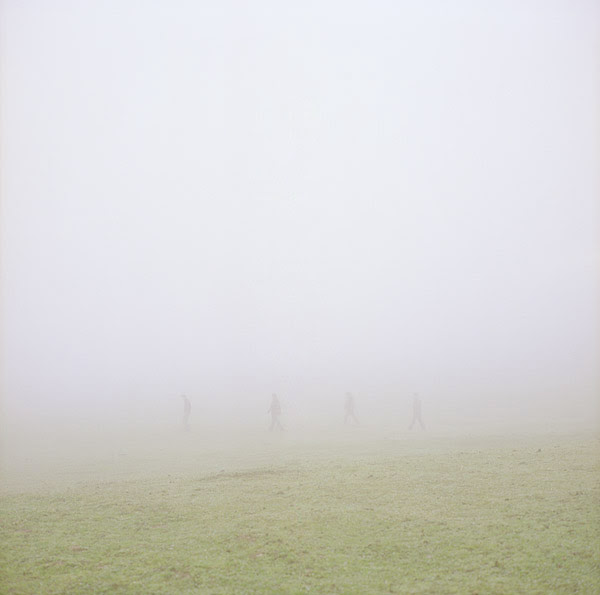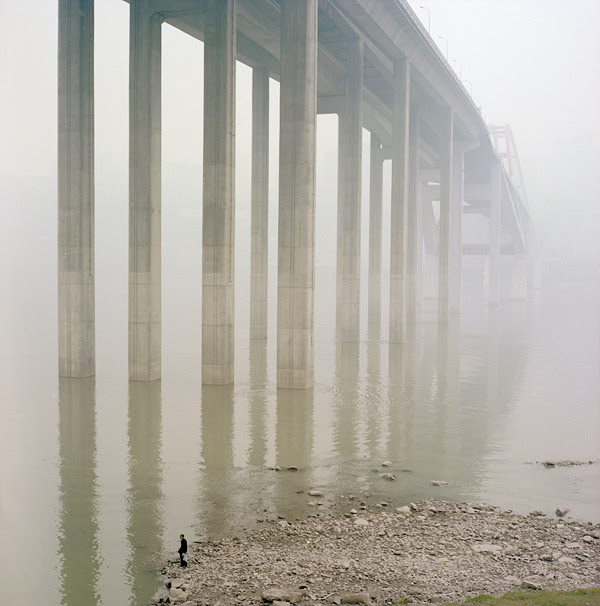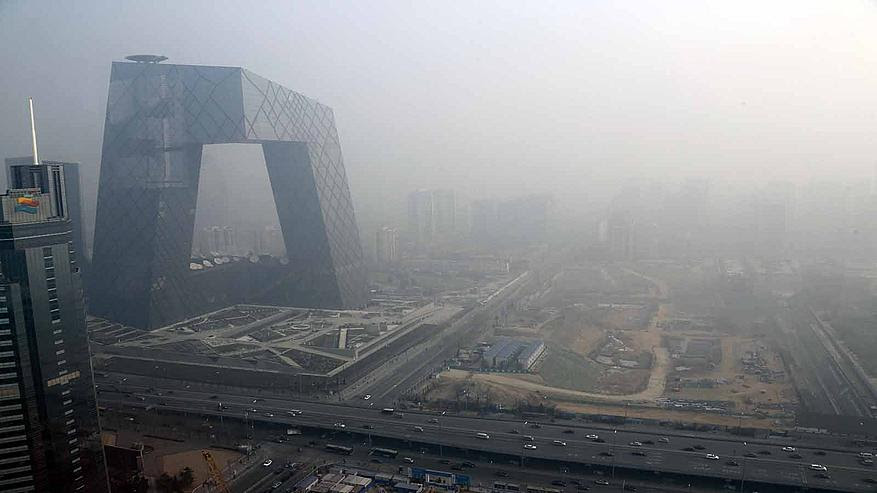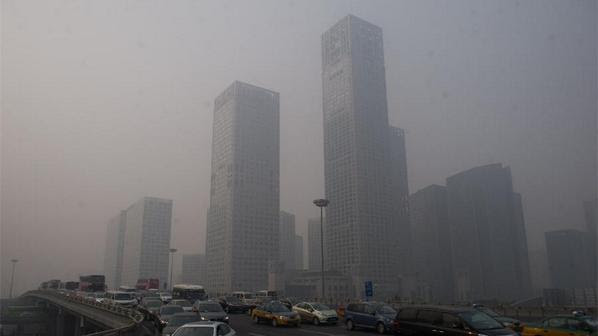#Smog-stricken #China woos #meteorological talents: official: image via Xinhua World News @Xinhua_Intl, 14 November 2014
Behind the screen

A woman wears a mask as she walks by the National Stadium on a hazy day in Beijing: photo by Ng Han Guan /AP via The Guardian, 25 February 2014

Weather authorities warn heavy #smog in north #China including Beijing, Tianjin and Hebei on Thursday: image via CCTVNEWS @cctvnews, 20 November 2014

Weather authorities warn heavy #smog in north #China including Beijing, Tianjin and Hebei on Thursday: image via CCTVNEWS @cctvnews, 20 November 2014
What annoys me about the apec summit, US & China agree to be greener by 2027? View from hotel room in Chang an #smog: image via Dan Dan @latachedanny, 20 November 2013

China World Trade Centre Tower III (C), one of the tallest buildings in the city at 330m (1083ft), in the heavy haze in Beijing. Beijing and broad swaths of six northern provinces have spent the past week blanketed in a dense pea-soup smog that is not expected to abate until Thursday. Beijing’s concentration of PM 2.5 particles –- those small enough to penetrate deep into the lungs and enter the bloodstream –- hit 505 micrograms per cubic metre on Tuesday night. The World Health Organisation recommends a safe level of 25: photo by Jason Lee / Reuters via The Guardian, 25 February 2014
Behind the screen
propped up before the mirror
that is also a shield
against the questions that can't be asked
the planet of the self deceived
struggles to breathe
through the fine mesh fabric
the no-answers mask An air
of misgiving thankless not-breath
the no-answers mask An air
of misgiving thankless not-breath
resignation . belated
howsoever suffocating withheld
going through the tunnel
Stinking viscous muck more lethal
before you even put it in your car
and set it on fire
going through the tunnel
Stinking viscous muck more lethal
before you even put it in your car
and set it on fire
The particulate aerosol mass
remains inarticulate
remains inarticulate
to the death

A woman wears a mask as she walks by the National Stadium on a hazy day in Beijing: photo by Ng Han Guan /AP via The Guardian, 25 February 2014

Weather authorities warn heavy #smog in north #China including Beijing, Tianjin and Hebei on Thursday: image via CCTVNEWS @cctvnews, 20 November 2014

Weather authorities warn heavy #smog in north #China including Beijing, Tianjin and Hebei on Thursday: image via CCTVNEWS @cctvnews, 20 November 2014
What annoys me about the apec summit, US & China agree to be greener by 2027? View from hotel room in Chang an #smog: image via Dan Dan @latachedanny, 20 November 2013

China World Trade Centre Tower III (C), one of the tallest buildings in the city at 330m (1083ft), in the heavy haze in Beijing. Beijing and broad swaths of six northern provinces have spent the past week blanketed in a dense pea-soup smog that is not expected to abate until Thursday. Beijing’s concentration of PM 2.5 particles –- those small enough to penetrate deep into the lungs and enter the bloodstream –- hit 505 micrograms per cubic metre on Tuesday night. The World Health Organisation recommends a safe level of 25: photo by Jason Lee / Reuters via The Guardian, 25 February 2014


Tourists from mainland China take photos in front of a large outdoor banner in in Hong Kong showing what the city looks like on a clean-air day: photo by Alex Hofford / EPA via The Guardian, 25 February 2014

A big screen flashes commercials on the exterior of an office building in Xi'an on 15 December 2012: photo by Mayi Wong / EPA via The Guardian, 25 February 2014

The Jinshanling Great Walls in Chengde, north of Beijing: photo by ChinaFotoPress / Getty Images via The Guardian, 25 February 2014

Great Wall cloaked in smog, Beijing: photo by Vicky (vicky tricky), 10 October 2005

Great Wall cloaked in smog, Beijing: photo by Vicky (vicky tricky), 10 October 2005
Atmospheric aerosols affect
weather and global general circulation by modifying cloud and
precipitation processes, but the
magnitude of cloud adjustment by aerosols
remains poorly quantified and represents the largest uncertainty in
estimated forcing
of climate change. Here we assess the
effects of anthropogenic aerosols on the Pacific storm track, using a
multiscale global
aerosol–climate model (GCM). Simulations
of two aerosol scenarios corresponding to the present day and
preindustrial conditions
reveal long-range transport of
anthropogenic aerosols across the north Pacific and large resulting
changes in the aerosol
optical depth, cloud droplet number
concentration, and cloud and ice water paths. Shortwave and longwave
cloud radiative forcing
at the top of atmosphere are changed by
−2.5 and +1.3 W m−2, respectively, by emission changes from
preindustrial to present day, and an increased cloud top height
indicates invigorated
midlatitude cyclones. The overall
increased precipitation and poleward heat transport reflect
intensification of the Pacific
storm track by anthropogenic aerosols.
Hence, this work provides, for the first time to the authors’ knowledge,
a global perspective
of the effects of Asian pollution outflows
from GCMs. Furthermore, our results suggest that the multiscale
modeling framework
is essential in producing the aerosol
invigoration effect of deep convective clouds on a global scale.
Yuan Wang, Minghuai Wang, Renyi Zhang, Steven J. Ghan, Yun Lin, Jiaxi Hu, Bowen Pan, Misti Levy, Jonathan H. Jiang, Mario J. Molina: Assessing the effects of anthropogenic aerosols on Pacific storm track using a multiscale global climate model: Proceedings of the National Academy of Science, 14 April 2014

Great Wall cloaked in smog, Beijing: photo by Vicky (vicky tricky), 10 October 2005

Great Wall cloaked in smog, Beijing: photo by Vicky (vicky tricky), 10 October 2005

A smog cloud is cast over a bridge in a tourist area in Hangzhou: photo by Lam Yik Fei / Getty Images via The Guardian, 25 February 2014

A view of downtown Shanghai on 5 December 2013: photo by Peter Parks / AFP via The Guardian, 25 February 2014

Buildings are seen through thick haze at the central business district in Guangzhou: photo by Alex Lee / Reuters via The Guardian, 25 February 2014

A big screen flashes commercials on the exterior of an office building in Xi'an on 15 December 2012: photo by Mayi Wong / EPA via The Guardian, 25 February 2014


A satellite view of northern China covered by pollution haze on 23 January 2014: photo by MODIS / Aqua/ NASA via The Guardian, 25 February 2014

Children with respiratory diseases receive treatment at a hospital in Hangzhou: photo by China Daily / Reuters via The Guardian, 25 February 2014

Heavy smog shrouds
the second ring road in Beijing, 21 January. The government had hoped
that rain and snow would disperse the smog that has blanketed the city
since last weekend, but an index monitoring of PM2.5 particulates
revealed that it still stood at 400 in some parts of the city -- down on
last week's record score of 755, but still well above levels deemed
hazardous to human health.
Beijing authorities have proposed new rules that would force more
factory shutdowns and increase fines for vehicle emissions when smog
reaches dangerous levels in the latest attempt to tackle the Chinese
capital's air pollution. The plans come a week after 'airpocalypse' --
when pollution levels in the city hit a level that was almost 40 times
more than the limit recommended by the World Health Organisation: photo by Adrian Bradshaw / EPA via the Guardian, 22 January 2013

An outdoor screen glimmers as heavy fog shrouds Zhengzhou, capital of central China's Henan province: photo by Zhu Xiang / Corbis via the Guardian, 22 January 2013

The Forbidden City in Beijing is shrouded in pollution: photo by Feng Li / Getty Images via the Guardian, 22 January 2013

On 12 January the Chinese meteorological authority issued a yellow alert indicating dangerous levels of smog in China's northern and western regions, including major cities like Beijing. It said that parts of China were facing the worst recorded pollution. According to Beijing Municipal Environmental Monitoring Centre website, density of PM2.5 particulates had surpassed 1,000 in Beijing -- the World Health Organisation considers a safe daily level to be 25 micrograms per cubic metre: photo by Rex Features via the Guardian, 22 January 2013

The CCTV tower is seen in heavy smog in Beijing. The city has seen a major spike in pollution-related illnesses with heart attacks and respiratory ailments: photo by Imaginechina/Corbis via the Guardian, 22 January 2013

Cars in heavy fog in Hefei, central China's Anhui province: photo by Stringer / AFP via the Guardian, 22 January 2013

A view of a busy highway as heavy smog engulfs the city of Beijing, 11 January: photo by How Hwee Young / EPA via the Guardian, 22 January 2013

Chimneys of a cement plant emit smoke into the air in Binzhou, in east China's Shandong province. Air pollution is a major problem in China due to the country's rapid pace of industrialisation, reliance on coal power, explosive growth in car ownership and lack of environmental regulation. It typically gets worse in the winter because of weather conditions and an increase in coal-burning for heating needs: photo by Zhang Bin / EPA via the Guardian, 22 January 2013

Power station chimney near Beijing's central business district on 18 January. Officials last week ordered some factories to close down, but reports from state media Xinhua indicate that the city government will propose new rules for tackling air pollution: photo by Feng Li / Getty Images via the Guardian, 22 January 2013

An outdoor screen glimmers as heavy fog shrouds Zhengzhou, capital of central China's Henan province: photo by Zhu Xiang / Corbis via the Guardian, 22 January 2013

The Forbidden City in Beijing is shrouded in pollution: photo by Feng Li / Getty Images via the Guardian, 22 January 2013

On 12 January the Chinese meteorological authority issued a yellow alert indicating dangerous levels of smog in China's northern and western regions, including major cities like Beijing. It said that parts of China were facing the worst recorded pollution. According to Beijing Municipal Environmental Monitoring Centre website, density of PM2.5 particulates had surpassed 1,000 in Beijing -- the World Health Organisation considers a safe daily level to be 25 micrograms per cubic metre: photo by Rex Features via the Guardian, 22 January 2013

The CCTV tower is seen in heavy smog in Beijing. The city has seen a major spike in pollution-related illnesses with heart attacks and respiratory ailments: photo by Imaginechina/Corbis via the Guardian, 22 January 2013

Cars in heavy fog in Hefei, central China's Anhui province: photo by Stringer / AFP via the Guardian, 22 January 2013

A view of a busy highway as heavy smog engulfs the city of Beijing, 11 January: photo by How Hwee Young / EPA via the Guardian, 22 January 2013

Chimneys of a cement plant emit smoke into the air in Binzhou, in east China's Shandong province. Air pollution is a major problem in China due to the country's rapid pace of industrialisation, reliance on coal power, explosive growth in car ownership and lack of environmental regulation. It typically gets worse in the winter because of weather conditions and an increase in coal-burning for heating needs: photo by Zhang Bin / EPA via the Guardian, 22 January 2013

Power station chimney near Beijing's central business district on 18 January. Officials last week ordered some factories to close down, but reports from state media Xinhua indicate that the city government will propose new rules for tackling air pollution: photo by Feng Li / Getty Images via the Guardian, 22 January 2013

The Oriental Pearl tower on a hazy day in Shanghai, 21 January: photo by Carlos Barria / Reuters via the Guardian, 22 January 2013

A woman wearing a mask walks under a bridge during severe pollution on 18 January in Beijing. Chinese factories and coal-fired power stations could soon face further rolling shutdowns, as the government battles to get a hold on the smog crisis that has gripped the capital: photo by Feng Li / Getty Images via the Guardian, 22 January 2013 via the Guardian, 22 January 2013

哈尔滨松花江. Despite heavy smog there is a lot of life on the frozen Songhua River, Harbin, China: photo by SinoLaZZeR, 23 November 2013

A woman wearing a mask checks her phone in front of Harbin's landmark San Sophia church. The second day of heavy smog has forced the closure of schools and highways, as visibility has been reduced to a few metres: photo by AP via The Guardian, 21 October 2013

Two women share a jacket to cover up their mouths and noses as they cross a street covered by dense smog. Small-particle pollution soared to a record 40 times higher than an international safety standard: photo by AP via The Guardian, 21 October 2013

People wear masks as they ride along a street in Daqing, Heilongjiang province. All of the province's highways and the Taiping international airport in Harbin have been forced to close: photo by Reuters via The Guardian, 21 October 2013

Smog shrouds buildings in Harbin. A red alert for thick smog has been issued in the provinces of Heilongjiang, Jilin and Liaoning: photo by Rex Features via The Guardian, 21 October 2013

People wait for transport in Harbin but many public bus routes were shut due to the smog: photo by Rex Features via The Guardian, 21 October 2013

A man covers his nose and mouth with a newspaper as he walks on the street in Harbin: photo by AP via The Guardian, 21 October 2013

A man pushes a bike onto a bridge in Harbin: photo by AP via The Guardian, 21 October 2013

The subjective city -- No. 5. Fisherman and his pregnant wife (Chongqing): photo by wang yuanling, 15 March 2009

Cowboy (Chongqing): photo by wang yuanling, 2009 [posted 7 January 2010]

Helmet (Chongqing): photo by wang yuanling, 2009 [posted 25 February 2010]

The subjective city -- No. 25. Goats on the way home (Chongqing): photo by wang yuanling, 22 July 2009

Go for a walk (Yangtze River): photo by wang yuanling, 24 October 2009

In the fog (Chongqing Wulong): photo by wang yuanling, 4 June 2010

Fog in the river (Yangtze): photo by wang yuanling, 15 October 2009

Bridge (Chongqing): photo by wang yuanling, 2009 [posted 7 January 2010]

The subjective city -- No. 8 (Chongqing): photo by wang yuanling, 16 March 2009

Take a picture for me, yeah! (Funny boys, Yangtze River, Sichuan): photo by wang yuanling, 16 March 2009

The subjective city -- No. 26. (Picnic, Yangtze River, Chongqing): photo by wang yuanling, 25 November 2009

Heavy #smog to hit #Beijing, Tianjin and Hebei from Thursday to Friday: image via CCTVNEWS @cctvnews, 29 October 2014

Heavy #smog to hit #Beijing, Tianjin and Hebei from Thursday to Friday: image via CCTVNEWS @cctvnews, 29 October 2014

Heavy haze hung in the air in central Beijing this week: photo by David Gray/Reuters, 7 December 2011

Paramilitary policemen practise drills inside the Forbidden City during a heavy haze and smog night in central Beijing: photo by Jason Lee / Reuters, 4 December 2011

Smog in Beijing: photo by David Gray / Reuters via the Guardian 15 April 2014

Paramilitary policemen practise drills inside the Forbidden City during a heavy haze and smog night in central Beijing: photo by Jason Lee / Reuters, 4 December 2011

Smog in Beijing: photo by David Gray / Reuters via the Guardian 15 April 2014


An employee walks past new cars at Ford's joint venture in Chongqing, China: photo by Reuters, 12 October 2012
What part of this makes you want to dismantle the EPA? #China #smog: image via Mike @ScottsHusband, 12 November 2014
#Beijing and the nearby Tianjin and Hebei will be once again shrouded by #smog: Image via China.org @chinaorgcn, 22 October 2014
A new spell of #smog is expected to affect central, northern #China over the weekend: Image via China.org @chinaorgcn, 16 October 2014
11 Minutes a day -- choking Beijing style: image via Team Carma @TeamCarma, 14 August 2014

The head (western China): photo by wang yuanling, 10 March 2012
The air quality index in Harbin soared to the maximum of 500 yesterday. #airpollution #smog: Image via China.org @chinaorgcn, 30 October 2014

Shijiazhuang, AQI 360, China 2014. This panoramic shot shows a city barely visible through thick fog. Only the title -– AQI 360 –- suggests there is something sinister here. AQI stands for ‘Air Quality Index’. The index runs from 1-500, where 0-50 is ‘good’ and 301-500 indicates a hazardous level of pollution. AQI 301-500 can aggravate heart or lung disease, lead to premature mortality in the elderly and cause serious respiratory problems in the general population: photo by Benedikt Partenheimer via The Guardian 18 November 2014










3 comments:
Tom,
"the planet . . . struggles to breathe" indeed -- shocking photos, poor Great Wall "cloaked in smog"
Steve,
Existing within the trapped air (do exhaust fumes constitute a form of air?) that pools under the trees along the freeway feeder here allows us to imagine our very own little piece of the Great Wall cloaked in smog, without even having to risk attempting to cross the street.
For of course it's One World (if not alas also One Love), anymore, the gorgeous sunsets over our refinery corridor now enriched by the generous billions of redundant megadeath particles flooding in on the jet stream from our esteemed "Developing" "Pacific Rim" "neighbours". ("Thanks for Sharing the Aerosols".)
We get to breathe it in every minute, while wowing at the astonishing Venetian sunsets thus created -- in thus wise getting a double barreled dose of instruction in what it means to live on a planet that's dying of its own religion, a strange cannibalistic worship of carbon gods whose power lingers on in the crushed remains of earlier strains of planetoids.
Dumb ones maybe, but hardly any less thoughtful than our own present strain, it increasingly appears.
The planet of the self-deceived
That line's painfully on the nail.
Post a Comment